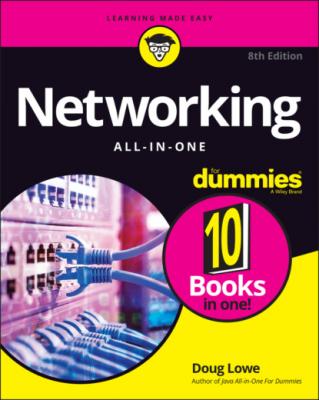Networking All-in-One For Dummies. Doug Lowe
Читать онлайн.| Название | Networking All-in-One For Dummies |
|---|---|
| Автор произведения | Doug Lowe |
| Жанр | Зарубежная компьютерная литература |
| Серия | |
| Издательство | Зарубежная компьютерная литература |
| Год выпуска | 0 |
| isbn | 9781119689058 |
10BaseT: Unshielded twisted-pair (UTP) cable became popular in the 1990s because it’s easier to install, lighter, and more reliable, and also it offers more flexibility in how networks are designed. 10BaseT networks use a star topology with hubs at the center of each star. Although the maximum length of 10BaseT cable is only 100 meters, hubs can be chained to extend networks well beyond the 100-meter limit.10BaseT cable has four pairs of wires twisted together throughout the entire span of the cable. However, 10BaseT uses only two of these wire pairs, so the unused pairs are spares.
Fast Ethernet
Fast Ethernet refers to Ethernet that runs at 100 Mbps, which is ten times the speed of Standard Ethernet. Although there are several varieties of Fast Ethernet, the most common is 100BaseTX, which transmits at 100 Mbps over just two pairs of a UTP cable. 100 Mbps Ethernet requires at least Cat-5 cable, but most networks are now wired with Cat-5e or Cat-6 cable, both of which are capable of gigabit speeds.
Gigabit Ethernet
Gigabit Ethernet is Ethernet running at a 1,000 Mbps, or 1 Gbps. Gigabit Ethernet was once considerably more expensive than Fast Ethernet, so it was used only when the improved performance justified the extra cost. However, today Gigabit Ethernet is the standard for nearly all desktop and laptop PCs. Two grades of cable are commonly used: Cat-5e and Cat-6; Cat-6 is preferred because it can be used for even faster networks.
Beyond gigabit
Several varieties of Ethernet faster than 1 Gbps on copper cable are available:
2.5GBase-T: 2.5 Gbps speed that can operate on Cat-5e cable.
5GBase-T: 5 Gbps speed that requires Cat-6 cable.
10GBase-T: 10 Gbps speed that requires Cat-6A cable.
25GBase-T: 25 Gbps speed that requires Cat-8 cable.
40GBase-T: 40 Gbps speed that also requires Cat-8 cable.
There are also many varieties of 10 Gbps, 40 Gbps, 100 Gbps, 200 Gbps, and even 400 Gbps Ethernet that run on fiber-optic cable. In the near future, terabit (1,000 Gbps) Ethernet may be possible.
The TCP/IP Protocol Suite
TCP/IP, the protocol on which the Internet is built, is not a single protocol but rather an entire suite of related protocols. TCP is even older than Ethernet. It was first conceived in 1969 by the Department of Defense. For more on the history of TCP/IP, see the sidebar, “The fascinating story of TCP/IP,” later in this chapter. Currently, the Internet Engineering Task Force (IETF) manages the TCP/IP protocol suite.
The TCP/IP suite is based on a four-layer model of networking similar to the seven-layer OSI model. Figure 1-7 shows how the TCP/IP model matches up with the OSI model and where some of the key TCP/IP protocols fit into the model. As you can see, the lowest layer of the model, the network interface layer, corresponds to the OSI model’s physical and data link layers. TCP/IP can run over a wide variety of network interface layer protocols, including Ethernet, as well as other protocols, such as token ring and FDDI (an older standard for fiber-optic networks).
FIGURE 1-7: TCP/IP and the OSI model.
The application layer of the TCP/IP model corresponds to the upper three layers of the OSI model — the session, presentation, and application layers. Many protocols can be used at this level. A few of the most popular are HTTP, FTP, Telnet, SMTP, DNS, and SNMP.
The names of Ethernet cable standards resemble the audible signals a quarterback might shout at the line of scrimmage. In reality, the cable designations consist of three parts:
The first number is the speed of the network in Mbps. So, 10BaseT is for 10 Mbps networks (Standard Ethernet), 100BaseTX is for 100 Mbps networks (Fast Ethernet), and 1000BaseT is for 1,000 Mbps networks (Gigabit Ethernet).
“Base” (short for “baseband”) indicates the type of network transmission that the cable uses. Baseband transmissions carry one signal at a time and are relatively simple to implement. The alternative to baseband is broadband, which can carry more than one signal at a time but is more difficult to implement. At one time, broadband incarnations of the 802.x networking standards existed, but they have all but fizzled due to lack of use.
The tail end of the designation indicates the cable type. For coaxial cables, a number is used that roughly indicates the maximum length of the cable in hundreds of meters. 10Base5 cables can run up to 500 meters. 10Base2 cables can run up to 185 meters. (The IEEE rounded 185 up to 200 to come up with the name 10Base2.) If the designation ends with a T, twisted-pair cable is used. Other letters are used for other types of cables.
In the following sections, I point out a few more details of the three most important protocols in the TCP/IP suite: IP, TCP, and UDP.
IP
Internet Protocol (IP) is a network layer protocol responsible for delivering packets to network devices. The IP protocol uses logical IP addresses to refer to individual devices rather than physical (MAC) addresses. Address Resolution Protocol (ARP) handles the task of converting IP addresses to MAC addresses.
Because IP addresses consist of a network part and a host part, IP is a routable protocol. As a result, IP can forward a packet to another network if the host isn’t on the current network. After all, the capability to route packets across networks is where IP gets its name. An Internet is a just a series of two or more connected TCP/IP networks that can be reached by routing.
